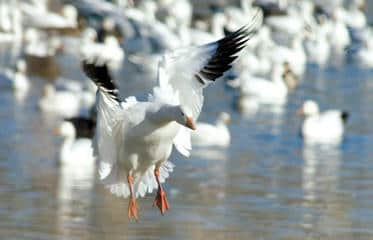Light Goose Conservation Order Provides Late-season Hunting in Kansas

The dark and light goose regular seasons end Sunday, Feb. 10, 2013. However, from Feb. 11-April 30, 2013, hunters can hunt snow and Ross’ geese during the Light Goose Conservation Order. The U.S. Fish and Wildlife Service established the special season 13 years ago to increase the harvest of light geese.
Since the mid-1970s, mid-continent light goose populations have increased more than 300 percent. These historic numbers of geese have denuded portions of their fragile tundra breeding habitat in the arctic, which may take decades to recover. This impacts other bird species that nest there, including semi-palmated sandpipers and red-necked phalaropes.
The harvest of light geese has more than doubled since the first conservation order in 1999, in turn reducing population growth. However, the management goal is to reduce the population of mid-continent light geese by 50 percent.
To increase hunter success, the conservation order authorizes hunting methods not allowed during the regular seasons, including the use of electronic calls and unplugged shotguns. Shooting hours are one-half hour before sunrise to one-half hour after sunset and there is no bag or possession limit for light geese.
For more information on goose hunting, visit www.ksoutdoors.com and click on “Hunting/When to Hunt/Migratory Birds.”

